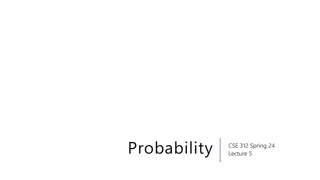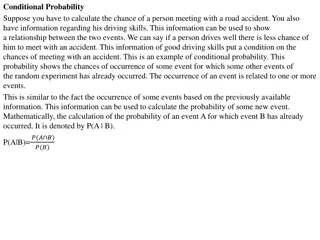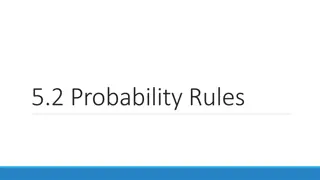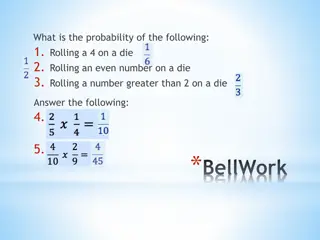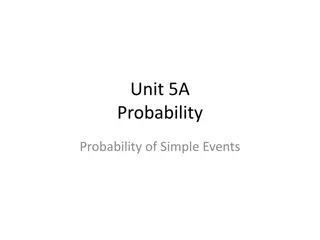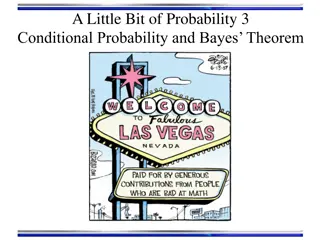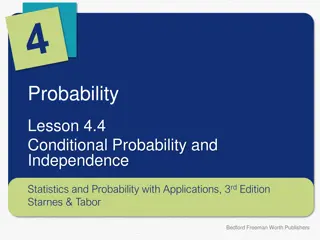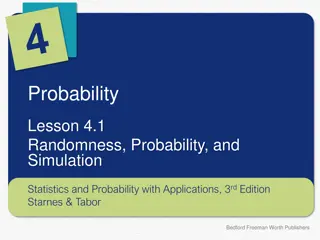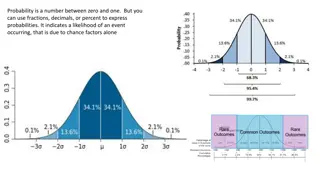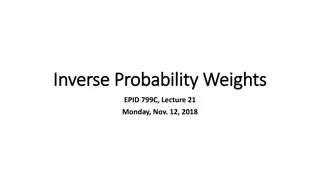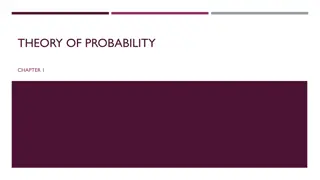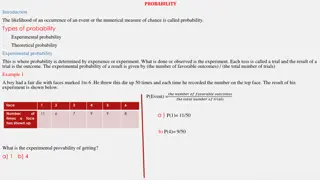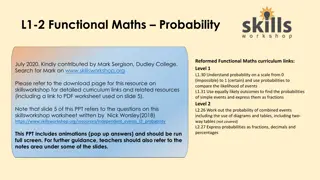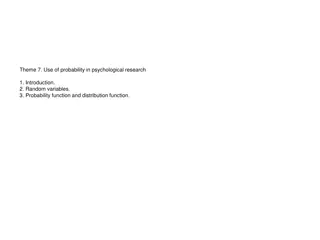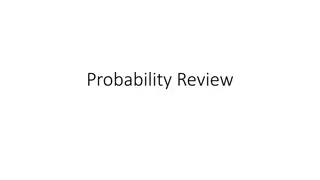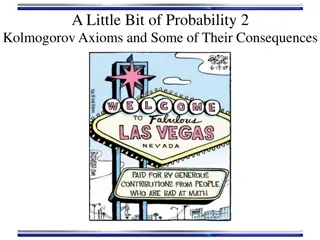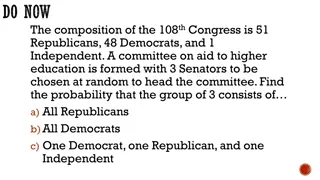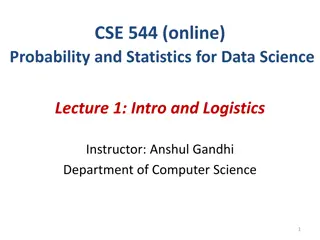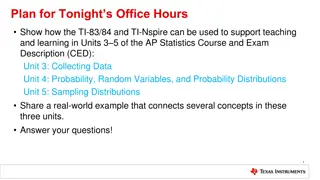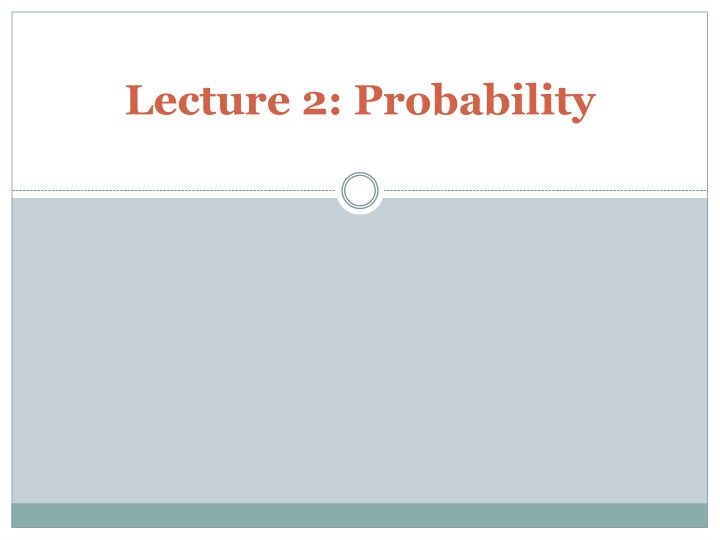
Probability Theory: Events, Outcomes, and Independence
Dive into the world of probability theory with discussions on events, outcomes, relative frequency, and elementary events. Learn about independent and mutually exclusive events, and how they impact probabilities in experiments. Explore the fundamental concepts through practical examples and explanations.
Download Presentation

Please find below an Image/Link to download the presentation.
The content on the website is provided AS IS for your information and personal use only. It may not be sold, licensed, or shared on other websites without obtaining consent from the author. If you encounter any issues during the download, it is possible that the publisher has removed the file from their server.
You are allowed to download the files provided on this website for personal or commercial use, subject to the condition that they are used lawfully. All files are the property of their respective owners.
The content on the website is provided AS IS for your information and personal use only. It may not be sold, licensed, or shared on other websites without obtaining consent from the author.
E N D
Presentation Transcript
Probability and Relative Frequency(1) Consider an experiment with a finite number of mutually exclusive outcomes which are equiprobable. Let A denote some event associated with the possible outcomes of the experiment. The probability P(A) of the event A is defined as the fraction of the outcomes in which A occurs: P(A) = N(A) , N where N is the total number of outcomes of the experiment and N(A) is the number of outcomes leading to the occurrence of the event A.
Probability and Relative Frequency(2) Suppose the experiment can be repeated any number of times, so that we can produce a whole series of independent trials under identical conditions, in each of which event A either occurs or does not occur. Let n be the total number of experiments in the whole series of trials, and let n(A) be the number of experiments in which A occurs. The relative frequency of the event A (in the given series of trials) is the ratio n(A) n . It turns out that the relative frequencies n(A) series of trials are virtually the same for large n, clustering about P(A). observed in different n
Elementary Events, Independent Events and Mutually Exclusive Events (1) The mutually exclusive outcomes of a random experiment are called elementary events. A typical elementary event will be denoted by . The set of all elementary events associated with a given experiment is called the sample space, denoted by . An event A is said to be associated with the elementary events of if, given any in , we can always decide whether or not leads to the occurrence of A.
Elementary Events, Independent Events and Mutually Exclusive Events (2) The same symbol A will be used to denote both the event A and the set of elementary events leading to the occurrence of A. An event A occurs if and only if one of the elementary events in the set A occurs. For an event A, the event A does not occur is called the complementary event of A, denoted by .
Elementary Events, Independent Events and Mutually Exclusive Events (3) Two events ?1and ?2are said to be independent if the occurrence of one event has no influence on the probability of the occurrence of the other. Two events ?1and ?2are said to be mutually exclusive or incompatible if the occurrence of one event precludes the occurrence of the other, i.e., if ?1 and ?2cannot occur simultaneously. In symbols, ?1and ?2are mutually exclusive if and only if ?1 ?2= .
Multiplication Rule If two events A1and A2are independent, P(?? ??) = P(??) P(??) . Generalization: If the events A1, A2 , , Akare all independent of each other, P(?? ?? ??) = P(??) P(??) P(Ak) .
Addition Rule (1) If two events A1and A2are mutually exclusive, P(?? ??) = P(??) + P(??) . Generalization: If Aiand Ajare mutually exclusive for any i and j, P(?? ?? ??) = P(??) + P(??) + + P(??). Obviously, A and are mutually exclusive, so P( A ) = P(A) + P( ?) . But P( A ? ) = P(?) = 1, from which we have P( ?) = 1 P(A) .
Addition Rule (2) If A1and A2are independent, A1and ?2are also independent, and P(?1 ?2) = P(?1) P(?2) = ( 1 P(?1)) ( 1 P(?2)) = 1 P(?1) P(?2) + (P(?1) P(?2)) = 1 P(?1) P(?2) + P(A1 ?2) = 1 P(?1 ?2) . Therefore, P(?? ??) = 1 P (?? ??) = 1 P(??) P(??) .
Problems (1) There are 12 girls and 8 boys in a class of 20. If a student is chosen at random, what is the probability that a boy is chosen? (2) On every school day the students draw lots to decide who will be on duty that day. In a week of 5 school days, what is the probability that all 5 students on duty are girls? (3) If a group of 5 is chosen from the above class, what is the probability that the group consists of girls only? (4) What is the probability that there is at least one boy in the group chosen above?
Problems (5) If 10 students are chosen at random from the class, what is the probability that exactly 6 are girls? (6) If the students draw lots on every school day to decide who will be on duty that day, in a week of 5 school days, what is the probability that (a) 3 girls and 2 boys are on duty, (b) no more than 3 girls are on duty, (c) no student is on duty for more than one day?
Problems (7) If each one of 20 students chooses at random a number from 1 to 100, what is the probability that the 20 chosen numbers are all different? (8) If the exam scripts of 20 students are distributed at random among the students, what is the probability that no one gets his/her own script?
Conditional Probability (1) The conditional probability of A on the hypothesis B, i.e., the probability of A occurring under the condition that B is known to have occurred, is defined by P(?|B) = ?(? ?) ?(?). As P(A B) = P(?|B) P(B) = P(?|A) P(A) , we have P(?|A) = P(?|B ) P(B) P(A). If A and B are independent, then P(? ?) = P(?) P(?), and P(?|B) = P(A).
Conditional Probability (2) Suppose B1, B2, , Bkis a full set of mutually exclusive events, i.e., B1 B2 Bk= and ?? Bj= for any distinct i and j. The total probability formula: P(A) = P(A|B1) P(B1) + P(A|B2) P(B2) + + P(A|Bk) P(Bk) .
Conditional Probability (3) Bayes rule: If ?1, ?2, , ??is a full set of mutually exclusive events, then for 1 ? ? , P(Bi|A) = P(A|B?) P(B?) P(A) P(A|B?) P(B?) = P(A|B1) P(B1) + P(A|B2) P(B2) + + P(A|Bk) P(Bk).
Problems (9) In a class of 12 girls and 8 boys, 7 of the girls and 5 of the boys are Chinese. All the others are not. If a Chinese student is chosen at random, what is the probability that a girl is chosen? (10) If a girl student is chosen at random from a class, the probability that she is Chinese is 60%. If a boy is chosen, the probability that he is Chinese is 70%. There are twice as many girls as boys in the class. If a Chinese student is chosen at random, what is the probability that a girl is chosen?
The Monty Hall Problem A guest X goes on a game show. He is given the choice of three doors. Behind one door is a car; behind the two others, goats. X picks a door, say No. 1, and the host H, who knows what is behind each door, opens another door, say No. 3, which has a goat. H then says to X, "Do you want to switch your choice to door No. 2?" Is it to X s advantage to switch his choice?
Monty Hall Problem: Solution (1) For ? = 1, 2 or 3, let ??denote the event that X chooses door No. i, ??denote the event that H opens door No. i, and ??denote the event that the car is behind door No. i. We want to find the probabilities P(C1| X1 H3) and P(C2| X1 H3).
Monty Hall Problem: Solution (2) To find P(C1| X1 H3) and P(C2| X1 H3) By Bayes s Rule, P(C1| X1 H3) =P(H3|X1 C1) P(X1 C1) , P(X1 H3) and P(C2| X1 H3) =P(H3|X1 C2) P(X1 C2) . P(X1 H3)
Monty Hall Problem: Solution (3) To find P(C1| X1 H3) and P(C2| X1 H3) Now P(C1) = P(C2) = P(C3) = 1 3, and as X1and Ciare independent, for i = 1, 2 or 3, P(X1 Ci) = P(X1) P(Ci). Therefore for i = 1, 2 or 3, P(X1 Ci) = 1 3P(X1) .
Monty Hall Problem: Solution (4) To find P(C1| X1 H3) and P(C2| X1 H3) Next we consider, for each position of the car, the probability of H opening door No. 3 after X chooses door No. 1, i.e., P(H3| X1) . First, if the car is behind door No. 1, H can open either No. 2 or No. 3. Assuming he has no reason to prefer one to the other, the probability that he opens No. 3 is 1 2, i.e., P(H3| X1 C1) = 1 2.
Monty Hall Problem: Solution (5) To find P(C1| X1 H3) and P(C2| X1 H3) If the car is behind door No. 2, H must open No. 3, i.e., P(H3| X1 C2) = 1. Finally, if the car is behind door No. 3, H will not open No. 3, i.e., P(H3| X1 C3) = 0.
Monty Hall Problem: Solution (6) To find P(C1| X1 H3) and P(C2| X1 H3) By the total probability formula: P(X1 H3) = P(X1 H3 C1) + P(X1 H3 C2) + P(X1 H3 C3) = P(H3 |X1 C1) P(X1 C1) + P(H3 |X1 C2) P(X1 C2) + P(H3 |X1 C3) P(X1 C3) = 1 2 1 = 1 3P(X1) + 1 1 3P(X1) + 0 1 3P(X1) 2P(X1) .
Monty Hall Problem: Solution (7) To find P(C1| X1 H3) and P(C2| X1 H3) Therefore, P(C1 |X1 H3) = P(H3|X1 C1) P(X1 C1) P(X1 H3) 3P(X1) 1 2 1 1 2P(X1) = 1 = 3, P(C2 |X1 H3) =P(H3|X1 C2) P(X1 C2) while P(X1 H3) 3P(X1) 1 1 1 2P(X1) = 2 = 3.

